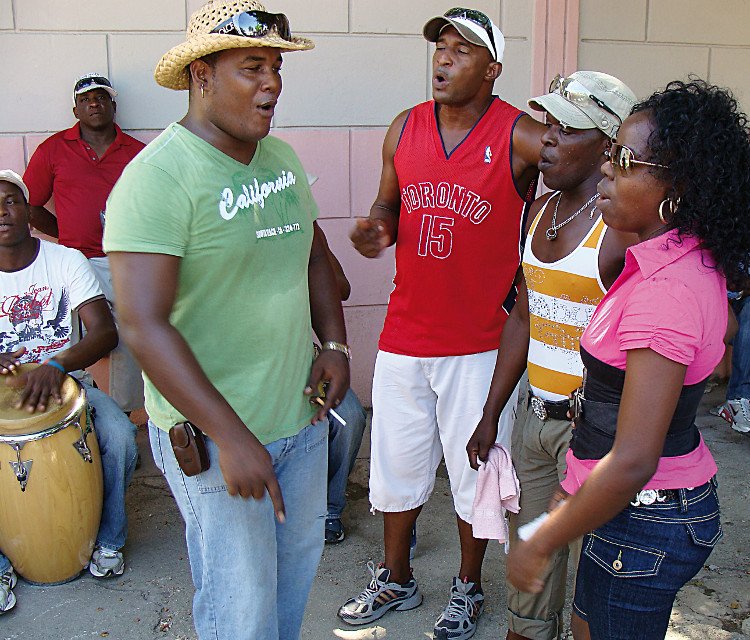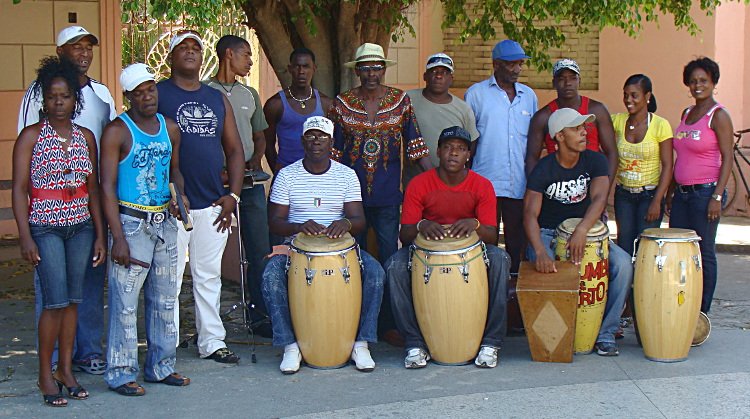RUMBA
Afro-Cuban Rhythms
In Cuba, the word rumba is used to describe a particular type of secular celebration that has its roots in various African and Afro-Cuban musical traditions. The traditions that have had the most influence on rumba are the African traditions of the bantu ethnic and linguistic group – known in Cuba as congos – and the traditions of the secret societies of the Afro-Cuban abakuá. Abakuá are the descendants of slaves belonging to any of the various African Calabar ethnicities.
Slavery lasted over three and a half centuries in Cuba, until 1886. In that year, over a quarter of a million men and women suddenly regained their freedom. As they did not own land, most of these people migrated to the cities in search of work. They improvised housing in the poor neighbourhoods of the cities, and it was common that many families lived together in abandoned buildings. Each family would occupy one private room and share the rest of the house with the other families. Generally, there would be a courtyard, or solar, situated at the centre of the house. As the kinship group grew and the population expanded the house would become increasingly crowded, and so the courtyard naturally became the place where the families would hold their social and cultural activities. It is in these courtyards that the rumba, one of the most powerful manifestations of Cuban popular music, was born.
This section of the population did not have the means to purchase musical instruments, so household objects were used for making music. Low-pitched sounds might be produced by drumming the sides of a cupboard with the hands; middle and high-pitched sounds might be got by hitting an upside-down drawer or the seat of a chair; and to this might be added the percussion of a spoon against a bottle – most probably a rum bottle. These improvised instruments were gradually replaced by boxes and crates of various sizes. These boxes and crates were not manufactured as instruments. The mountains and the countryside were too far away from the cities for wood to be found to make drums from, so drums were improvised from the empty containers obtained for free from nearby shops.
These percussion instruments were played polyrythmically to accompany the song of a soloist and a small choir of a few individuals, who alternated in a call and response pattern. The main aim of the music was to incite the audience to dance. In this way, in Cuba the word rumba became synonymous with parties in general.
The drums that we know today gradually appeared, replacing the old crates and boxes. These new drums were made of staves joined together in a barrel shape, with a piece of skin or leather stretched across the top. They were used in threes, like the old crates, and each of the three was named according to its size. The one with the lowest pitch was called hembra, meaning female; the middle drum was called macho, meaning male; and the smallest and most high-pitched was called quinto, or fifth.
These drums were referred to as tumbadoras. They later became an integral part of Cuban carnivals, which explains why today they are better known as congas. The rumba was the main form of music and dance at carnivals, and the music that accompanies carnival processions in general was called conga. Tumbadoras thus became identified by the many foreigners (especially North Americans) who attended these dazzling festivites as the drums used for playing conga, and from there they became known simply as congas.
These tumbadoras, or congas, having their origins in the Cuban rumba, constitute today perhaps Cuba's most significant contribution to the world heritage of musical instruments. They have spread from the rumba to other Cuban music and dance traditions, and further afield to North American jazz, international salsa and even, sporadically, rock, pop and contemporary classical music.
The three most well-known types of Cuban rumba are yambú, guaguancó and columbia. The yambú is the slowest of the three, and expresses respect for age and wisdom. The guaguancó depicts life and fertility. It is a dance of attack and evasion between a man and a woman, where the man attempts to jab the woman's pelvis while she protects herself with her hand or the hem of her skirt. The man's gestures are called vacunaos. Urban guaguancó dancing is perpetuating in this way ancient African fertility symbolism.
The columbia is the fastest rumba dance. It has the most acrobatic movements and the most arduous rhythms of all the carnival dances. The columbia takes the form of a duel between a male dancer and the player of the smallest drum, the quinto, which is the drum generally used for improvising the more complex and most convulsive rhythms. The quinto challenges the dancer to show that his dance steps can be even more complex than the rhythms on the drum. The competition ends when one of them has shown his superiority over the other.
The name of the group to be heard on this CD, Columbia del Puerto, refers to the columbia and to one of the major places of origin of Cuban rumba: the seaports of the coastal cities of western Cuba. The recordings on this CD constitute an excellent introduction to rumba music and its three main genres, with columbia taking pride of place. The music is played in the matancero style (the group is from Cárdenas, a port in the province of Matanzas), which is different from the style of Havana.
Columbia del Puerto was started by Mario Hernández Cortina in the early 1970s with the function of enticing dockers at Cárdenas to step forward when volunteers were being recruited for occasional work. The group's members were also seaport workers, and in these men's daily lives the rumba constituted the primary type of celebration. The group first performed on May 17th 1972, and from then on has been part of the amateur arts movement developed at the Gonzalo Roig cultural centre in Cárdenas.
The group's present line-up is mainly composed of the descendants of dockers who worked at the Cárdenas seaport and a few of whom are still alive today. The rumba tradition bequeathed to them through several generations is loyally being perpetuated and revitalised by the group under the direction of Jesús Hernández.
Columbia del Puerto have received the “Grupo Insignia” prize of the province of Matanzas and the “Hijos Ilustres” prize of the city of Cárdenas for their contribution to preserving the traditions of their native region. In the course of their international tours, Columbia del Puerto have received prizes in Bulgaria, Poland and Nicaragua. They have shared the stage with several famous Cuban music groups such as Van-Van, Pupy y Los que Son Son, NG la Banda and Orquesta Aragón, as well as with excellent rumba groups like Yoruba Andabo and Clave y Guaguancó.
The recordings on this CD make up a fine sample of present-day Cuban rumba. They witness to the power and energy with which the rumba tradition within Cuban music lives on in the 21st century.
Dr. Olavo Alén Rodríguez

